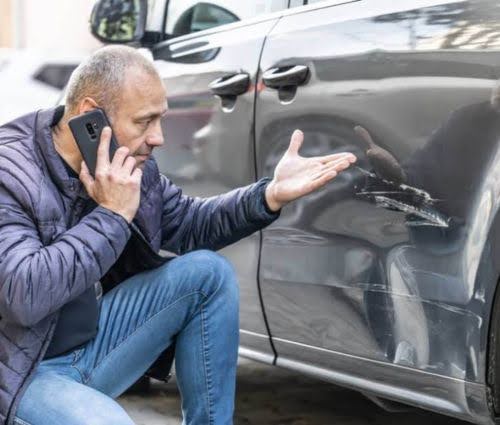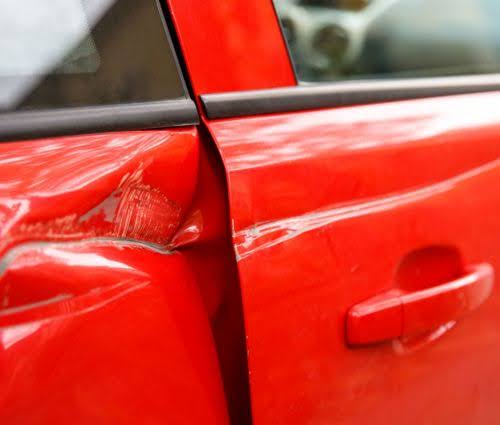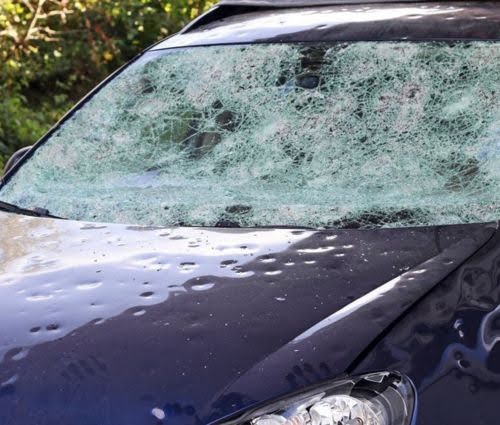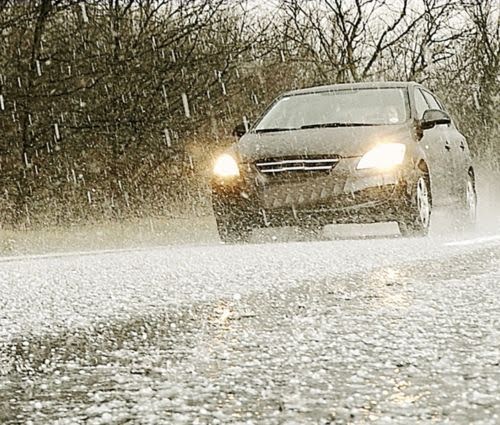Consequences of Neglecting Hail Damage on Vehicles
Vehicle Maintenance & Repairs
Minor Dents May Expand and Cause Costly Repairs

Even minor dents should not be ignored, as ignoring hail damage can lead to more serious issues. Temperature fluctuations cause metal to expand and contract, worsening dents over time. This can lead to long-term hail damage effects, such as cracked paint, which exposes the vehicle’s surface to moisture and debris.
If left unaddressed, what starts as a small dent may require Immediate Hail Damage Repair in the future. Delaying repairs also increases the risk of rust from hail damage. Moisture buildup in exposed dents accelerates corrosion, weakening the vehicle’s structure.

Corrosion and Rust Development Caused by Hail Damage
One of the most significant risks of ignoring hail damage is the potential for rust to develop. Even small dents can compromise a vehicle’s paint, allowing moisture to seep in and accelerate corrosion. Once rust from hail damage begins, it spreads quickly, weakening the vehicle’s metal structure. What might have been a simple fix with PDR for hail dents can turn into an expensive and time-consuming repair if rust is left unchecked.
Rust weakens the integrity of body panels, leading to costly replacements. Over time, long-term hail damage effects can result in large rust spots, making the car more vulnerable to further deterioration. Preventing rust by addressing dents early is far easier and more affordable than fixing rusted-out panels.
Choosing PDR for Hail Dents eliminates the risk of paint damage, helping to maintain the vehicle’s exterior and prevent rust from forming. By taking immediate action, car owners can avoid expensive repairs and preserve their vehicle’s structural integrity for years to come. Choosing PDR for hail dents early prevents further deterioration, helping maintain the car’s appearance and value while avoiding expensive bodywork later on.
Increasing Repair Expenses and Costs Due to Delayed Repairs

The cost of delaying hail repair can quickly escalate if minor dents are left untreated. Small dents may not seem urgent, but over time, they can lead to cracked paint, rust, or even structural damage. When the paint is compromised, moisture seeps into the metal, accelerating rust from hail damage. Addressing these issues early with PDR for hail dents is far more affordable than waiting until major repairs become necessary.
Ignoring hail damage may also result in larger dents due to temperature changes causing metal expansion and contraction. This makes the repair process more complex and costly. Choosing PDR for hail dents early prevents unnecessary expenses while keeping the vehicle in its best condition. Delaying hail damage repairs can have serious financial consequences, especially when dealing with insurance claims.

Failing to do so may result in a denied claim, leaving you to cover the repair costs out of pocket. If another hailstorm occurs before the initial damage is fixed, your insurance may not cover the new dents, considering them pre-existing damage. Addressing repairs promptly confirms you receive full coverage and avoid unexpected expenses. Beyond insurance concerns, prompt dent repair helps maintain your vehicle’s structural integrity and resale value. Over time, untreated dents can lead to rust and corrosion, turning what could have been a simple PDR fix into an expensive bodywork restoration.
Once paint is compromised, moisture seeps in, accelerating deterioration and reducing your car’s longevity. Investing in professional hail repair early prevents these long-term issues and preserves your vehicle’s factory finish. By acting quickly, you not only save money but also certify your car remains in excellent condition for years to come. Don’t wait, schedule your Hail Damage Repair today to protect your investment.
Lower Resale or Exchange Value from Vehicle Damage
Ignoring hail damage can significantly impact a vehicle’s resale or trade-in value. Buyers and dealerships view visible dents as a sign of neglect, making them less willing to offer top dollar. Even minor dents can create the impression that the vehicle has not been well-maintained, lowering its market value.
Addressing long-term hail damage effects early secures that the car retains its worth and remains attractive to potential buyers. The cost of delaying hail repair can result in even greater depreciation over time. If dents lead to rust from hail damage or cracked paint, the damage becomes more difficult and expensive to fix.
Dealerships often deduct repair costs from trade-in values, meaning owners get less for their vehicle than if they had repaired the damage beforehand. Choosing PDR for hail dents helps maintain the car’s original appearance and value. A well-maintained exterior is important when selling or trading in a vehicle. Investing in professional dent repair now can lead to higher resale offers in the future.
Risk of Structural Damage Caused by Hailstorms
Many people believe that ignoring hail damage only affects a vehicle’s appearance, but dents in key areas can weaken structural integrity. Hail dents near doors, roofs, or quarter panels may cause misalignment.
These long-term hail damage effects can lead to gaps, which increase stress on hinges, seals, and windows. Left untreated, this misalignment can contribute to additional wear and tear on connected components. Small dents may also compromise the protective coatings on a vehicle, increasing the risk of rust from hail damage.
If moisture seeps into these areas, it can further weaken the vehicle’s body, making future repairs more extensive and expensive. PDR for hail dents is a proactive way to prevent structural damage.

By restoring the car’s original shape early, owners can avoid unnecessary repairs and maintain the vehicle’s safety and durability. Addressing hail damage promptly protects the vehicle’s framework and prevents costly structural issues down the road. Buyers are more likely to purchase a car with no visible damage, making early repairs a smart financial decision. Waiting too long to repair hail damage could lead to insurance issues. Many policies have specific timeframes for filing claims, and delaying repairs could result in out-of-pocket costs.
Hail Damage Insurance Claim Challenges and Complications
Waiting too long to repair hail damage can create serious complications with insurance claims. Many policies have strict timeframes for filing claims, and ignoring hail damage may lead to denials or out-of-pocket expenses. The cost of delaying hail repair becomes apparent when small dents progress into larger issues that are harder to repair. Insurance providers expect prompt action, and delays may jeopardize the claim process, forcing owners to cover repair costs themselves.
If another hailstorm occurs before previous damage is addressed, insurers might refuse to cover additional claims. This scenario often results in significant financial burdens for vehicle owners, as long-term hail damage effects accumulate. Moreover, unresolved damage increases the likelihood of rust from hail damage, further complicating insurance settlements. In these cases, delays not only diminish repair quality but also disrupt the insurer’s willingness to provide complete coverage.
Timely repairs using PDR for hail dents can mitigate these issues by restoring the vehicle’s condition before additional damage occurs. Addressing dents promptly helps maintain accurate records for claims and prevents disputes over repair responsibilities. Acting swiftly confirms that insurance processes run smoothly, protecting vehicle value and avoiding costly, unexpected expenses. Choosing PDR for hail repair also minimizes downtime, allowing you to get back on the road faster without the hassle of extensive bodywork. By working with a trusted repair shop, you can assure high-quality results that keep your vehicle looking and performing its best.
How Hail Damage Affects Resale Value

Hail damage can significantly impact your vehicle’s resale value, especially if dents and dings are left unrepaired. Potential buyers often view visible damage as a sign of neglect, making them hesitant to pay full market value. Even minor dents can lower your car’s appraisal, reducing trade-in or resale offers. Unrepaired hail damage can also lead to long-term issues such as paint deterioration and rust, further decreasing the vehicle’s worth.
Investing in Professional Hail Damage Repair confirm that your car retains its market value and remains visually appealing. Paintless dent repair (PDR) removes dents without affecting the factory paint, preserving the car’s original finish. Whether selling or trading in your vehicle, addressing hail damage early helps you secure the best possible price.

Potential Consequences of Postponing Hail Damage Repairs
Ignoring hail damage can result in long-term issues that go beyond cosmetic concerns. Small dents may seem minor, but over time, they can lead to cracked paint, rust from hail damage, and structural weaknesses. Addressing dents early with PDR for hail dents helps maintain the vehicle’s factory finish, preventing costly bodywork down the line. The cost of delaying hail repair increases when untreated damage leads to larger dents, requiring extensive repairs or even panel replacements.
Taking immediate action confirms your vehicle remains in top condition. Long-term hail damage effects can significantly decrease resale value, making it harder to trade in or sell a vehicle at a fair price. Using PDR for hail dents not only preserves the car’s appearance but also protects its structural integrity. Repairing hail damage early is the best way to avoid expensive repairs, insurance claim complications, and unnecessary depreciation.

VIP Hail Service | Plano, TX
Professional Hail Repair
Stay Up-to-date With Our Content
Subscribe to learn more about our mission!


